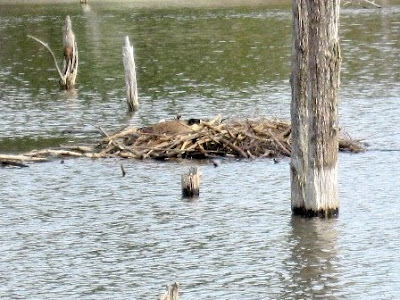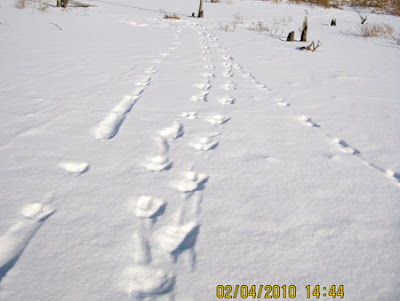
When I decided I had to write about what happened at the Lost Swamp Pond on the morning of April 28, I told myself that straight off I should explain that the nesting goose never moved. Then I looked up and saw the goose lift her right wing. That the goose didn’t move for an hour when both beavers were on the lodge where it was nesting, and didn’t move when the otter fished around the lodge blasted two of my theories. From years of observations, I know beavers shy from geese, and otters can’t resist getting a rise out of them. Evidently I have not observed long enough.
I do not subscribe to the theory that beavers only come out at night. I’ve frequently seen them in the day

and even have a theory that when otters are around one beaver from the family resident in the pond will keep a wary eye out for them, and try to ward them off when they appear.
So when I sat by the pond and saw the beaver and goose sitting peacefully on the lodge in the middle of the pond, I lost the beaver-shy-of-geese theory but could still cling to my beaver-watching-for-otters theory, until four otters swam off the shore between me and the beaver. As I cursed myself for not bringing my camcorder out with me and used the video function of my digital camera, the otters fished right in front of the beaver and it didn’t bat an eye.
So much for the beaver-ward-off-otter theory. I don’t subscribe to the otters-eat-beavers theory and so wasn’t surprised when the otters didn’t pay any attention to the beaver. And maybe they didn’t see the goose rather low on her nest with a beaver looming large right next to her.
But that the otters were even in the pond contradicted at least two theories. From long observation I know, or knew, that, in the spring, otters find little to eat in the beaver ponds they winter in. This family of four otters, a mother and three pups (the pop otter is a rolling stone and then some and seldom bothers the family) had been in this pond off and on for two months during February and March.

Sometimes visiting two neighboring ponds but spending most of their time here. They dug a hole through the dam and drained out half the water in the pond leaving pools of water under the ice making it easier to catch the fish trying to survive the winter there.

So theoretically with the thaw, there is going to be little left for otters to eat in the pond. There is also a widely accepted theory, that I ascribe to, that otter families break up at least by March. The mother otter gives birth to new pups in April, thanks to delayed implantation of the embryo that is the upshot of mating last March or April, which means, the mother tends to separate from her current pups in February the better to enjoy the wild, often over hill and dale, courtship that otters have in the late winter. During the winter I eagerly watched for otter slides in the pond confirming that theory and my particular slant on it is that the mother separates from her pups after leading them on wild chases all over their territory.
I theorized that there would be a wild chase in February. There wasn’t. When they moved maybe every seven days or so, the four otters usual went no farther than 100 yards down to the next pond.

Then in March, in one day, they went 150 yards in the other direction to another pond. Then the snow melted and I could take comfort in not seeing conformation of my theory every time I went to the ponds.
I theorized that if I actually saw the otters again -- last time I saw them was in December,

I would see the three pups alone, or the mother alone. And lo and behold, on April 9 I saw three otters together. One certainly acted like a mother busying herself with fishing and two goofed around with each other like pups, but theories are powerful things and I theorized that it was possible that one of the pups was wise beyond its years and was a big sister who had become like a mother to the other two. Then two days later I saw four otters together, the mother and three pups.

Finally a week later I stopped seeing piles of scat left by four otters on the shore, and then I saw one otter, and it saw me, and, I thought it looked bold with tail cocked up, much like a male, which supported my theory that the bull male otter who rules over a wide expanse of territory, makes a tour of his domain in April, leaving scats in prominent places and, in this case, prodding otter families that he helped create go about their business, to wit, for the mother to mate and raise new pups and the old pups now juveniles to prepare for dispersing to, well, not many theories on that…. Then two days later I saw the family of four otters again.

So that day I saw the goose, beaver and otters together, I lay behind a rock grasping for theories to cling to all the while delighting at the antics of the otters, which, to be sure, were contrary to my theories. Over the years I have documented the maturation of otter pups with video clips showing how by October or November at the latest they stop their incessant playing and begin catching fish as they seriously explore every corner of the pond that scarcely contains them at that moment. True once in March I saw a family of otters pop out of a hole in the ice and play deliriously for five minutes before going back into the hole
but I theorized that any animal popping out of a hole in the ice in the winter would let loose in the soft snow for at least five minutes. And as I watched the otter family destroy my theories in the ponds in March, and April and, yes, May, I took comfort in the fact that the pups, now juveniles, did act serious half the time. Then as the rest of the family nuzzled and pooped on the shore across from me,
one juvenile otter broke off from the family, swam over to the lodge where the beaver and goose were, and began fishing right next to it making as much noise as possible, slapping its tail, when it dove into the water, maybe even imitating a beaver that often slaps its tail. Contrary to my theory the beaver, who couldn’t miss seeing and hearing the otter’s display, did not budge. The goose seemed oblivious, too.
This especially hurt because what little reputation I have in otter circles is based on my theory of otter-beaver interactions which decrees that in beaver ponds at least, beavers make a point of putting otters in their place. I gave a paper on this at an international otter conference (in Frostburg, Maryland) where I was half believed, which is to say, the delegates enjoyed my six video clips of bold beavers staring down increasingly frantic otters.
At least the otter did not even try to attack the beaver which would go against my theory. Then I noticed another beaver swimming in the water right below me. Since the otters had not noticed me, probably because there was stiff wind blowing into face, by my theories the beaver would not notice me because after years of observation I’ve determined that otters have better sight and better sense of smell than beavers. And since I wasn’t making a noise the beaver’s superior hearing wouldn’t come into play. Then the beaver turned and looked at me, turned tail to me, and slapped its tail. I do not subscribe to the theory that beavers slap their tails to alert other beavers of danger. They do it to scare away any given nuisance, be it human, otter, goose, deer, etc. Sometimes the beaver slaps its tail again and again, and I do withdraw. Fortunately today it only did it once and swam slowly out to the lodge where the beaver there didn’t react at all to the tail slap. Nor did the otters who continued playing on the shore and then splashed back into the pond and began fishing behind the beaver dam. I watched with that stoic calm one has when almost all one’s theories have been blasted. Almost. One remained: otters would not attack a beaver in a beaver pond.
Then the beaver didn’t go up on the lodge with the other beaver. It continued swimming slowly, head up, out toward the otters. I have seen that several times before, and as in other instances, one of the otters dove and judging from the wake didn’t flee. Just as I've seen before, the beaver swam over where the otter dove as if daring it to come up nose to nose. I saw two of the otters prop themselves up on logs around another beaver lodge near the dam. They both screeched at the beaver, sounding much like angry cats. The beaver swam toward them. One otter splashed down into the water. But didn’t attack. I was watching this through a pair of busted binoculars, only one lens worked. So I had to scan the four otters and their angry display and then try to spot the swimming beaver. I saw the beaver swim away, looked for the otters and saw that all four otters were swimming farther up the pond away from the beaver, away from the lodge, just as my theory dictates!
Soon the otters were briefly out of sight and then they swam down a shore as far away from the beavers as possible and swam around a peninsula and then swam up toward a far reach of the pond well out of sight of the beavers. The beaver that warded off the otters swam to the lodge where the other beaver was resting. My guess is that the resting beaver is pregnant, which might explain that solidarity between beaver and nesting goose. Beavers are monogamous for life and even more so than humans, but they are rarely demonstratively affectionate with their long time mate. But I saw her rise up and greet her hero by offering her nose for an affectionate bump. He sort of accepted that but quickly bowed his head and let her groom his fur.

One theory preserved, a half dozen blasted. I laughed, announced my theory of the immovable goose, and then saw her wing move. I started to walk around the pond then I saw that the otters were swimming back. I hid again and watched as the otters didn’t exactly destroy my one remaining theory. They didn’t attack the beavers, but they did amend the theory. Yes, beavers do drive otters out of their pond, but the otters can come back, and in this case, as the heroic beaver’s groomed fur dried into a reddish hue,

the otters swam triumphantly into the lodge by the dam where the beaver had just braved them off. But now that beaver remained placidly on the lodge out in the pond basking in its earlier heroics. Technically my theory survived: when they have a mind to do it, beavers drive otters off, but that leaves plenty of time and space for otters to preserve their honor. Faced with otter honor and beaver love, theories must obey. But during all that crash of theories and other excitement, the goose needed to do nothing more than adjust a few wing feathers.
No comments:
Post a Comment